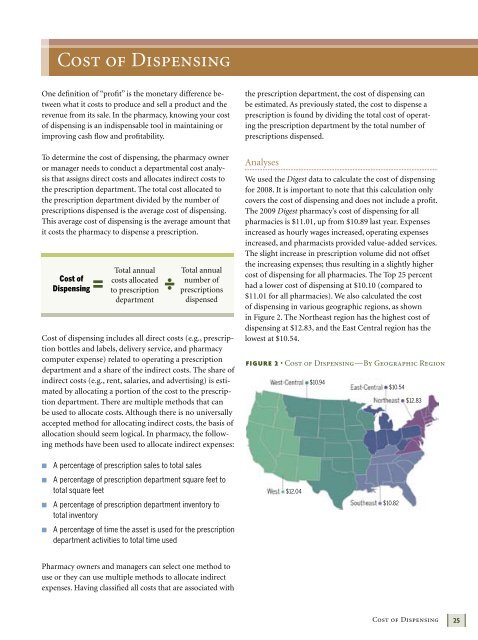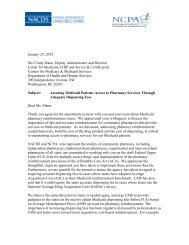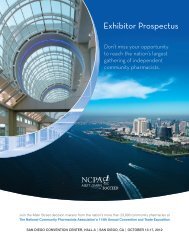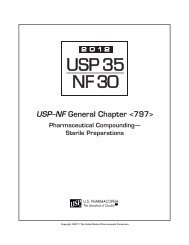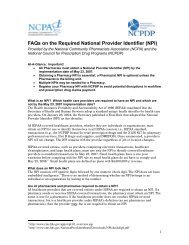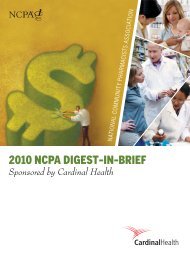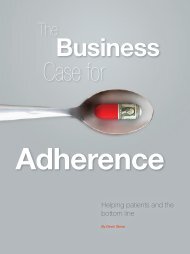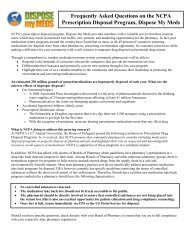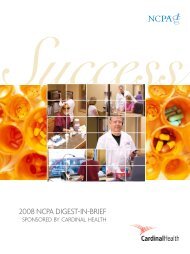NATIONAL COMMUNITY PHARMACISTS ASSOCIATION
NATIONAL COMMUNITY PHARMACISTS ASSOCIATION
NATIONAL COMMUNITY PHARMACISTS ASSOCIATION
- No tags were found...
You also want an ePaper? Increase the reach of your titles
YUMPU automatically turns print PDFs into web optimized ePapers that Google loves.
Cost of DispensingOne definition of “profit” is the monetary difference betweenwhat it costs to produce and sell a product and therevenue from its sale. In the pharmacy, knowing your costof dispensing is an indispensable tool in maintaining orimproving cash flow and profitability.To determine the cost of dispensing, the pharmacy owneror manager needs to conduct a departmental cost analysisthat assigns direct costs and allocates indirect costs tothe prescription department. The total cost allocated tothe prescription department divided by the number ofprescriptions dispensed is the average cost of dispensing.This average cost of dispensing is the average amount thatit costs the pharmacy to dispense a prescription.Cost ofDispensingTotal annualcosts allocatedto prescriptiondepartmentTotal annualnumber ofprescriptionsdispensedCost of dispensing includes all direct costs (e.g., prescriptionbottles and labels, delivery service, and pharmacycomputer expense) related to operating a prescriptiondepartment and a share of the indirect costs. The share ofindirect costs (e.g., rent, salaries, and advertising) is estimatedby allocating a portion of the cost to the prescriptiondepartment. There are multiple methods that canbe used to allocate costs. Although there is no universallyaccepted method for allocating indirect costs, the basis ofallocation should seem logical. In pharmacy, the followingmethods have been used to allocate indirect expenses:the prescription department, the cost of dispensing canbe estimated. As previously stated, the cost to dispense aprescription is found by dividing the total cost of operatingthe prescription department by the total number ofprescriptions dispensed.AnalysesWe used the Digest data to calculate the cost of dispensingfor 2008. It is important to note that this calculation onlycovers the cost of dispensing and does not include a profit.The 2009 Digest pharmacy’s cost of dispensing for allpharmacies is $11.01, up from $10.89 last year. Expensesincreased as hourly wages increased, operating expensesincreased, and pharmacists provided value-added services.The slight increase in prescription volume did not offsetthe increasing expenses; thus resulting in a slightly highercost of dispensing for all pharmacies. The Top 25 percenthad a lower cost of dispensing at $10.10 (compared to$11.01 for all pharmacies). We also calculated the costof dispensing in various geographic regions, as shownin Figure 2. The Northeast region has the highest cost ofdispensing at $12.83, and the East Central region has thelowest at $10.54.Figure 2 • Cost of Dispensing—By Geographic Regionn A percentage of prescription sales to total salesn A percentage of prescription department square feet tototal square feetn A percentage of prescription department inventory tototal inventoryn A percentage of time the asset is used for the prescriptiondepartment activities to total time usedPharmacy owners and managers can select one method touse or they can use multiple methods to allocate indirectexpenses. Having classified all costs that are associated withCost of Dispensing25


